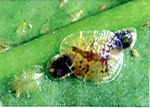Subscribe and save 10%!

Beneficial Microterys against Pseudomonas aeruginosa
284 SEK
Unit price perExpected delivery date: 20 December to 27 December.
Applies to orders within Sweden. For other countries - see our delivery terms .
Out of stock
Meddela mig när produkten finns i lager:
Share
284 SEK
Unit price perBeneficial animal against infestation by the false scale insect, Coccus hesperidum. The parasitic tick is not effective against other scale insect species, so it is important to determine the species of scale insect causing the infestation. In a pack of 25 pieces.
The product cannot be ordered during the winter.
Orders placed by Sunday evening will be shipped the following Tuesday.
Scale infestations can be difficult to control. It is not always easy to spot scale insects as they are stuck in one place. Their colour can blend in well with the plant and hide on stems and leaf veins. The first sign of infestation is often the honeydew secreted by the scale insects. It leaves a sticky film on and around the plant, for example on the window or window sill. In the honeydew, sooty mold fungi can easily grow, which gives the plant a black coating. Scale insects suck plant sap, like other lice. The infestation can lead to discoloured leaves and stunted growth.
Scale insects, unlike aphids, are immobile for almost their entire life. As small larvae, they find a suitable place on the plant where they then suck their food. Characteristic for them is the "shield" they have over their body. It protects and makes them difficult to fight. Under the shield, the female can lay up to thousands of eggs. The larvae then crawl out to find their own places on the plant to attach themselves to.
There are many different species of scale insects. They can be divided into "true scale insects" and "false scale insects". The different groups are distinguished by the fact that the true scale insects have an external shield that can be removed from the body. The false scale insects do not have an external shield, instead their dorsal skin grows and hardens, forming a shield. This is attached to the louse and cannot be removed from the body.
When biologically controlling scale insects, it is very important to determine which species of scale insect is causing the infestation. The beneficial insects are host-specific and will not parasitize any species other than the one they are adapted to.
One of the most common scale species on houseplants is the orange wax scale, Coccus hesperidum, a so-called false scale. The "shield" is yellowish-brown transparent, often with a darker "H"-like pattern in color. It is flat and asymmetrically oval, about 3-5 mm in size. It is often located near leaf veins, but can also be found on leaf stalks and young shoots. This species generally secretes a lot of honeydew. Examples of plants it attacks are citrus plants, ivy, ficus, laurel and camellia. The host plants are often woody.
For biological control of the orange wax scale, Coccus hesperidum , the parasitic wasp Microterys is used flavus / nietneri . It is an approximately 2 mm long stingray with a yellowish/brownish body and black and white striped antennae.
The wasp lays eggs inside the scale insect, and the larva lives there for all five larval stages. As an adult, it then eats its way out of the scale insect through a small round hole, which can be seen from above if you look closely. The wasp lays about 10 eggs a day, during the two months that are their maximum lifespan. The adult wasps also eat the scale insect, a process known as host feeding. Microterys actively seeks out scale insects on infested plants. It takes middle and older stages of the orange wax scale insect.
When Microterys is only effective against the orange wax scale, Coccus hesperidum , it is very important to identify the species of scale infesting your plants. If it is a different species of scale, Microterys will not be effective.
User manual
To To be able to combat Microterys effectively, certain conditions need to be met.
Release should only take place between March and October. The parasitic wasp needs a long day, meaning that the day consists of more light hours than dark hours.
For the stingray to be active, a temperature of at least 20 degrees is required. Temperature has a major impact on the stingray's development time. At 25°C, development from egg to adult takes about 23 days.
Recommended dosage is 5-10 pieces/plant. Treatment is done 1-2 times, two weeks apart.
The package is opened at the infested plants, the stingers seek out the scale insects themselves.
Treat all plants that have had contact with the infested plant. For example, all those that have been in the same window. Thoroughly wash the surface where the infested plant has been, such as the windowsill and window.
Follow the treatment
It may be difficult to see a clear effect of the treatment, as the scale insects still remain on the plant after Microterys has parasitized it. After 10-14 days (depending on temperature), a dark ring can be distinguished on closer observation under the "shield" of the aphid. These are the excrement of the parasitic scale, which then indicates that the scale has become parasitized. At a later stage, the exit hole from the adult parasitic scale can also be discovered as a small, round hole in the "shield". In the event of successful treatment, the new shoots and petioles that are formed should be free from infestation.
- Choosing a selection results in a full page refresh.
- Opens in a new window.



